"京都、心のふるさと | Kyoto, the hometown of the heart"
About:
Kyoto, Japan, was founded in the 8th century as Heian-kyō, serving as Japan's capital for over a thousand years. It became a center for culture, religion, and politics, fostering the development of many traditional Japanese arts. Despite wars and fires, many historic structures were preserved. Post-World War II, Kyoto evolved into a major part of Japan's economy and industry, while maintaining its historical heritage. Today, it's renowned for its well-preserved temples, shrines, and traditional wooden houses.
When to visit:
Kyoto, a city in Japan known for its rich history and cultural heritage, is a popular destination for tourists seeking to immerse themselves in traditional Japanese customs and architecture. The best time to visit Kyoto on a holiday is during the spring season, particularly in April when the cherry blossoms are in full bloom, creating a picturesque and enchanting atmosphere throughout the city. This time of year also coincides with the annual Hanami festival, where locals and visitors alike gather to admire the beauty of the cherry blossoms. Additionally, autumn is another recommended time to visit Kyoto, as the city's foliage transforms into vibrant hues of red, orange, and yellow, offering a stunning backdrop for sightseeing and photography.
When to avoid:
Traveling to Kyoto during the peak holiday season in the months of April and November can be particularly challenging due to the large influx of tourists. These months coincide with the cherry blossom season in April and the autumn foliage season in November, attracting visitors from around the world. As a result, popular sites can become crowded, leading to long lines and difficulty in finding accommodations. Travelers seeking a more tranquil experience may consider visiting Kyoto during the shoulder seasons in spring or fall to avoid the crowds and enjoy a more relaxed exploration of this historic city.
Winter Season (Dec-Feb)
In Kyoto, winter (December to February) is the coldest portion of the year. Temperatures range from 1°C to 10°C. Rainfall is moderate, with January being the driest month. Sunlight is limited with shorter days and cloud cover is prevalent, especially in February. Snowfall is rare but possible. An average day for a visitor would involve bracing the cold under layers of warm clothing. Despite the chilly conditions, the winter scenery is beautiful, with temples and gardens covered in frost, offering a unique, serene atmosphere.
Summer (July-September)
In Kyoto, the warmest part of the year is from June to September, with July and August being the peak of summer. During these months, temperatures typically range between 28°C (82°F) to 35°C (95°F), with the highest temperatures generally occurring in August.
Rainfall during this period is quite high, especially in June and July, which is the rainy season known as Tsuyu. The average monthly rainfall during these months can be around 180-240mm. Despite the rain, there's still plenty of sunlight, with daily average of 5-6 hours.
Humidity levels are also high throughout the summer, often exceeding 70%. This, combined with the high temperatures, can make the weather feel quite muggy and uncomfortable at times.
As for cloudiness, the summer months tend to have more cloud cover due to the rainy season and the high humidity. However, there are still plenty of clear, sunny days, especially as summer progresses into August.
A typical day for a visitor in Kyoto during the warmest part of the year would start off warm and humid, with temperatures rising quickly in the morning. Afternoons can be hot, and there's a good chance of rain or even a thunderstorm, particularly in June and July. Despite the rain and humidity, the city's numerous temples, shrines, and gardens remain beautifully lush and verdant, offering a unique charm.
Language:
The primary language spoken in Kyoto is Japanese. However, due to the city's status as a major tourist destination, English is also commonly used, particularly in areas frequented by international visitors. Additionally, other Asian languages such as Chinese and Korean can be heard due to the high number of tourists from these regions.




